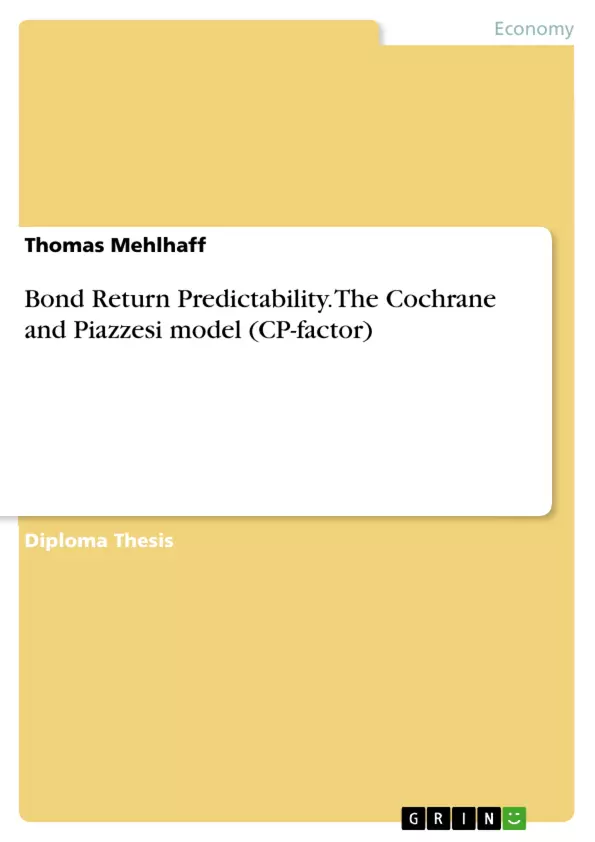The present work deals with the headline topic of bond return predictability and to some extent with foreign exchange predictability. After a short overview of past research on bond return predictability the present work predominantely deals with the Cochrane-Piazzesi factor (CP-factor) which seemlingly predicts lagged bond excess returns better than all known models so far. The model is tested on a bunch of different data sets from different countries and underscores the superiority of this model in comparison to other bond predictability models, which are also explained. In the last section of the present work the CP-factor is used in order to test whether it is possible to explain the forward premium puzzle and thus is able to predict changes and excess returns in foreign exchange rates.
Inhaltsverzeichnis (Table of Contents)
- Introduction.
- Bond return predictability in financial literature.
- Introduction
- The expectation hypothesis.
- The Fama and Bliss model
- The Campbell and Shiller model
- The Cochrane and Piazzesi model
- The Cochrane and Piazzesi model
- Short overview.
- Data and statistical issues
- Methodology
- Results
- What kind of risk is captured by the CP-factor?
- Critical appraisal.
- Conclusion.
- Testing the CP-factor on different data sets.
- The extended UFB data set.
- The Gurkaynak data set
- CP-factor on Canada.
- CP-factor on Germany.
- CP-factor on other countries (Datastream data set).
- Summary of bond return predictability.
- The CP-factor and FX predictability
- Theoretical background concerning FX rates and FX forward contracts.
- UIP: Empirical findings
- UIP and the CP-factor differential
- Excess returns in FX rates and the CP-differential
- Conclusion
Zielsetzung und Themenschwerpunkte (Objectives and Key Themes)
This master's thesis examines the predictability of bond returns, focusing on the Cochrane and Piazzesi (CP) model and its implications for foreign exchange (FX) predictability. The primary objective is to assess the validity and robustness of the CP-factor in explaining bond return patterns, particularly in light of its potential application to FX markets.
- Bond Return Predictability
- Cochrane and Piazzesi (CP) Model
- CP-Factor's Robustness and Applicability
- FX Predictability and the CP-Factor
- Uncovered Interest Parity (UIP)
Zusammenfassung der Kapitel (Chapter Summaries)
The thesis begins by providing a comprehensive overview of bond return predictability in financial literature. This chapter reviews various models, including the expectation hypothesis, Fama and Bliss model, and the Campbell and Shiller model, laying the groundwork for the analysis of the CP-factor.
Chapter 3 delves into the CP-factor, providing a detailed explanation of the model, its underlying theory, and the data and statistical issues associated with its estimation. This chapter also presents the results of the model's application and discusses the kind of risk captured by the CP-factor.
Chapter 4 investigates the robustness of the CP-factor across different data sets. The analysis considers both the extended UFB data set, the Gurkaynak data set, and data from Canada, Germany, and other countries. This chapter provides insights into the consistency of the CP-factor's predictive power.
Chapter 5 explores the relationship between the CP-factor and FX predictability. The chapter begins by reviewing theoretical background on FX rates and FX forward contracts and explores the implications of the CP-factor for UIP, a fundamental theory in international finance.
Schlüsselwörter (Keywords)
The core keywords of this master's thesis are bond return predictability, Cochrane and Piazzesi model, CP-factor, FX predictability, uncovered interest parity, yield curve, risk premium, and empirical finance.
- Quote paper
- Thomas Mehlhaff (Author), 2015, Bond Return Predictability. The Cochrane and Piazzesi model (CP-factor), Munich, GRIN Verlag, https://www.grin.com/document/314871



